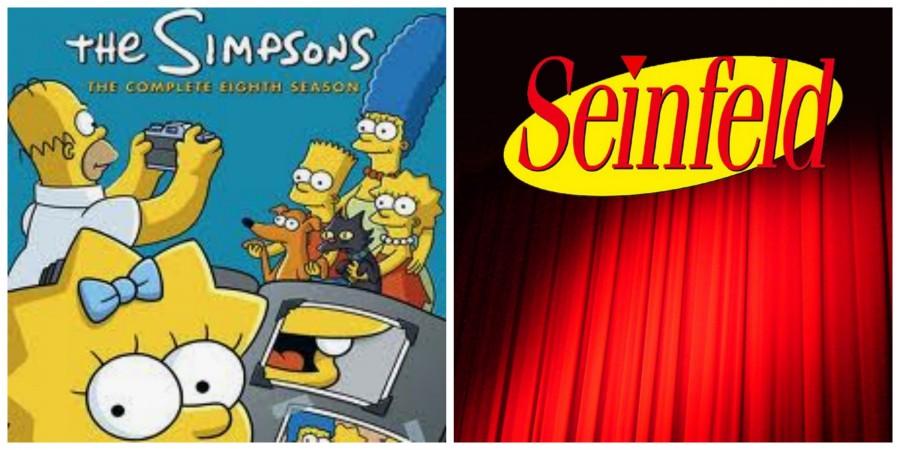The serious side of ‘The Simpsons’ and ‘Seinfeld’
September 30, 2014
By Robert Lloyd
Twenty-five years ago — in 1989, to save you the math — two situation comedies premiered, each destined to become American institutions, even as each regarded American institutions with a jaundiced and ironic eye. One was a cartoon, set in a midsized Anytown called Springfield, the other a seemingly standard sitcom set in a semi-mythic Manhattan. Yet they were very much of a piece, in the way that their characters — a family in the former, in the latter a family in all but name — viewed and rebuked the world.
“The Simpsons,” which began its 26th season Sunday on Fox, is the longest-running comedy or drama in the history of American prime-time TV, not to say a worldwide phenomenon. “Seinfeld,” the first scripted series to charge $1 million for a minute of commercial airtime, left the field of its own volition after nine seasons, co-creator and star Jerry Seinfeld refusing $110 million to make a 10th — but it has been in reruns ever since and still seems very much with us. Seventy-six million people watched its finale.
Each changed the way we talked; each provided a cracked lens through which to view the whole wide world. And though the Simpsons are biologically related — it seems funny to write that — the main quartet of “Seinfeld,” whom I’ll call the Seinfelds, also constitute a family. They are tied together by something more than choice, something closer to fate; together they create the home where, in the Robert Frost formulation, when you go there they have to take you in. They are the people whose differences the others can stand, as opposed to everyone else they meet, who will betray their tolerance eventually, with a personality quirk or physical characteristic.
In the first two decades of television, the family comedy, with some exceptions, was a straightforward endorsement of middle-class values and postwar ideas of normalcy. This was a time when there was no war — or rather, No War As Such — business was good, and social change was held to a slow enough pace that the beneficiaries of the status quo were not, with certain regional exceptions, excessively rattled. In the culture products that modeled Americans to Americans, parents were wiser than their children, though children sometimes could teach their parents a lesson — and lessons were learned — and the unit always stayed intact.
“Seinfeld” was created in purposeful contradiction to historical television mores. “No hugging, no learning” was its battle cry, and it stayed true to that code to the end. That the Simpsons were uneducable was a necessary component of a show whose characters never aged — though the characters changed as the writers and actors plumbed their essence or turned them to new uses, real enlightenment was never forthcoming.
“The Simpsons” and “Seinfeld” weren’t the first inversions of the classical ideal. “All in the Family,” the 1971 product of the social splits that rent the late ‘60s, was a functioning dysfunctional family sitcom; “Buffalo Bill,” the much-lauded 1983 Dabney Coleman comedy, made a selfish jerk its central character. Of their own time was Fox’s “Married … with Children,” which premiered in 1987 (the same year that “Simpsons” shorts began appearing on “The Tracey Ullman Show”). It ran a decade, was remade in many nations the world over and was not without a kind of negational brilliance — but it was perhaps too low in its humor, too angry, too thoroughly downmarket to seem to stand for anything larger.
But when “The Simpsons” and “Seinfeld” arrived, it was the homelier sitcoms that held sway. It was the age of “The Cosby Show” (which “The Simpsons” were put against for a time), “Full House,” “Who’s the Boss?” “Charles in Charge” and “Mr. Belvedere.” “Family Ties” had just finished its own long run.
Why them, and why then? It might be no coincidence that we were at the end of eight years of Reaganism and at the dawn of the first Bush administration, years marked by their ballyhooing of inherent American goodness, rooted in a nostalgia for an imagined past built of picket fences and neighborly neighbors, whose millennial return would render social programs, if not all government, irrelevant. However sincerely some might have believed this, it was also a cynical time in which selfishness gained a kind of cultural respectability: The late 1980s was also the era of Oliver Stone’s “Wall Street,” whose line “Greed is good” was variously interpreted as an ironic indictment and a design for living.
Blind cheerfulness alone is enough to get a satirist going, a breed born to find the canker, even in good times — but times are never that good. Simply put, “The Simpsons” took the skeptical tone of creator Matt Groening’s “Life in Hell” and ran it through the sitcom-based smarts and sensibilities of its co-developers, James Brooks and Sam Simon, to produce something that was both highly critical of human society and endeavor — every aspect and strand of it, political, economic, sexual, moral, even biological — and capable of world domination: It is a takedown that also serves as a celebration.
Like “The Simpsons,” “Seinfeld” — though often said to be “about nothing” — is potentially about everything, from big cultural trends to dipping a chip in dip after having taken a bite from it, making pearls from a single grain of irritating sand. Both the Simpsons and the Seinfelds exist in a more or less permanent state of war, occasionally relieved by small triumphs or moments of self-satisfaction to be wiped away by the next compulsive obsession or obsessive compulsion, the next perceived slight, the next self-inflicted misfortune, the next scheme gone wrong.
That the series struck chords, and not necessarily chords they meant to strike, is underscored by a body of literature that includes “The Gospel According to The Simpsons: The Spiritual Life of the World’s Most Animated Family,” “The Psychology of The Simpsons: D’oh!,” “The Simpsons and Philosophy: The D’oh! of Homer” and “The Simpsons in the Classroom: Embiggening the Learning Experience with the Wisdom of Springfield.”
“Seinfeld” has been taken with similar seriousness. A collection titled “Seinfeld and Philosophy: A Book About Everything and Nothing” includes among its essays “George’s Failed Zest for Happiness: An Aristotelian Analysis,” “Making Something Out of Nothing: Seinfeld, Sophistry and the Tao” and “Seinfeld, Subjectivity, and Sartre.”
Oddly, among them, the Simpsons are the more sympathetic characters. They do learn, temporarily. They can be hurt; they cry tears; they hug; the worst of them exhibit a vestigial conscience when necessary. They have emotions to accompany their appetites, where the Seinfelds have mostly appetites; rather, what emotions they have fall mostly in the range of anger, frustration and envy, though they do also take great delight in being proved right about inconsequential things.
Whatever ill transpires among them in the course of an episode, they are always together at the end, if often merely in a defensive position; they are masters of their domain, in the less figurative sense, but only of their domain. Because they live in episodic sitcoms, which reset to zero with every new installment, their unity will be preserved, as will their lack of progress, like Vladimir and Estragon every morning after Godot doesn’t come, again.
Given that we are standing on its far side, there’s nothing about their near-total cultural penetration that doesn’t feel somehow inevitable. And yet there is something of the fluke about them. “Seinfeld” especially seems so particular to its Upper West Side milieu that it’s always struck me a little odd that it has made any sense at all, let alone been embraced by large tracts of the country — think of the famous Saul Steinberg map of America as seen from New York but in reverse. To be sure, there’s a monkey-house aspect to both series, with their large casts of freaks and losers. And, of course, the jokes are good.
It must also be that we see ourselves in them, at least a little — their dissatisfactions, their desires. Everyone’s world is a little out of joint; everyone knows what it feels like to want that extra doughnut, or whatever “doughnut” means to you. But perhaps most of all it’s because we are needy and recognize their neediness: that we find a certain pleasure, even a grace, watching characters who, for all their flaws and fights, have one another — who were together at the beginning and will be together at the end.
©2014 Los Angeles Times
Visit the Los Angeles Times at www.latimes.com
Distributed by MCT Information Services
















